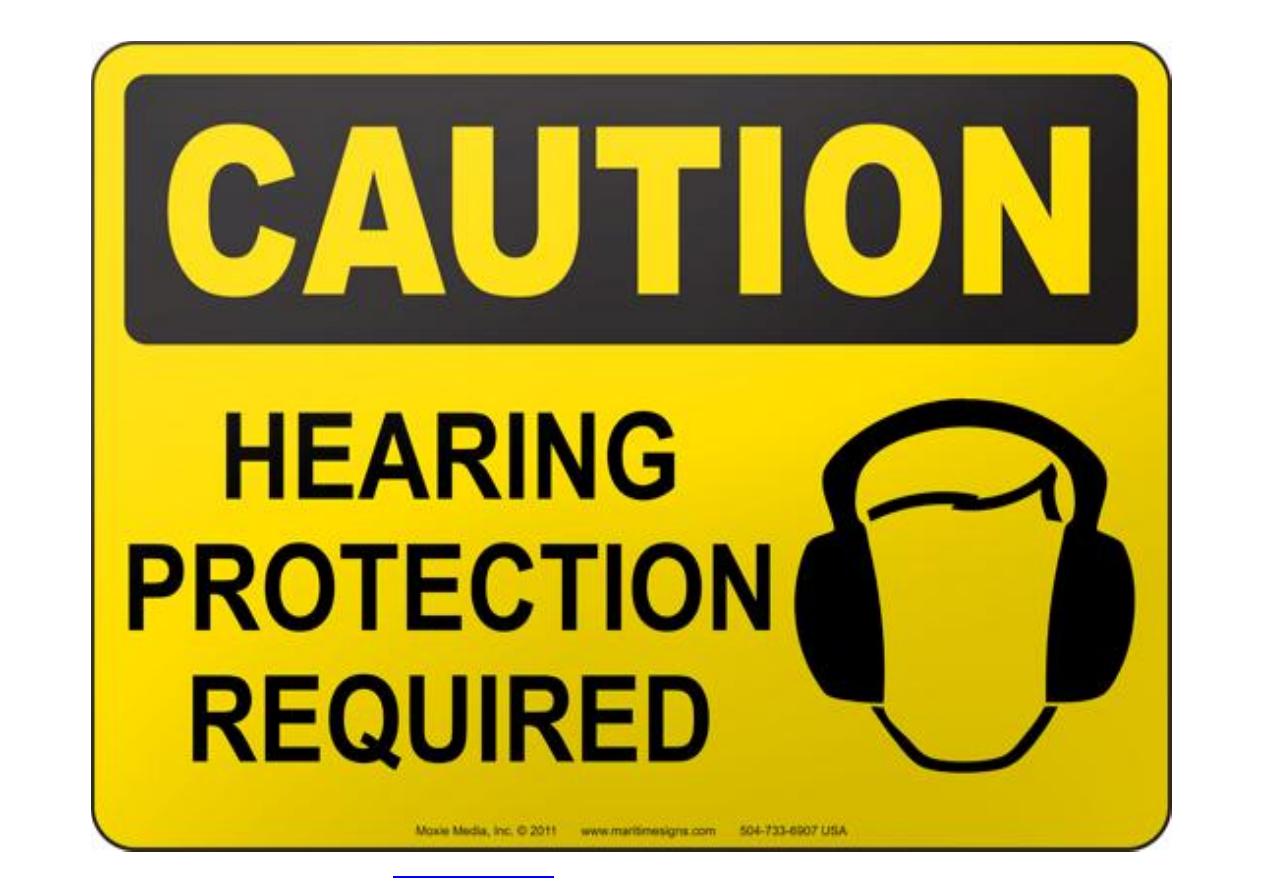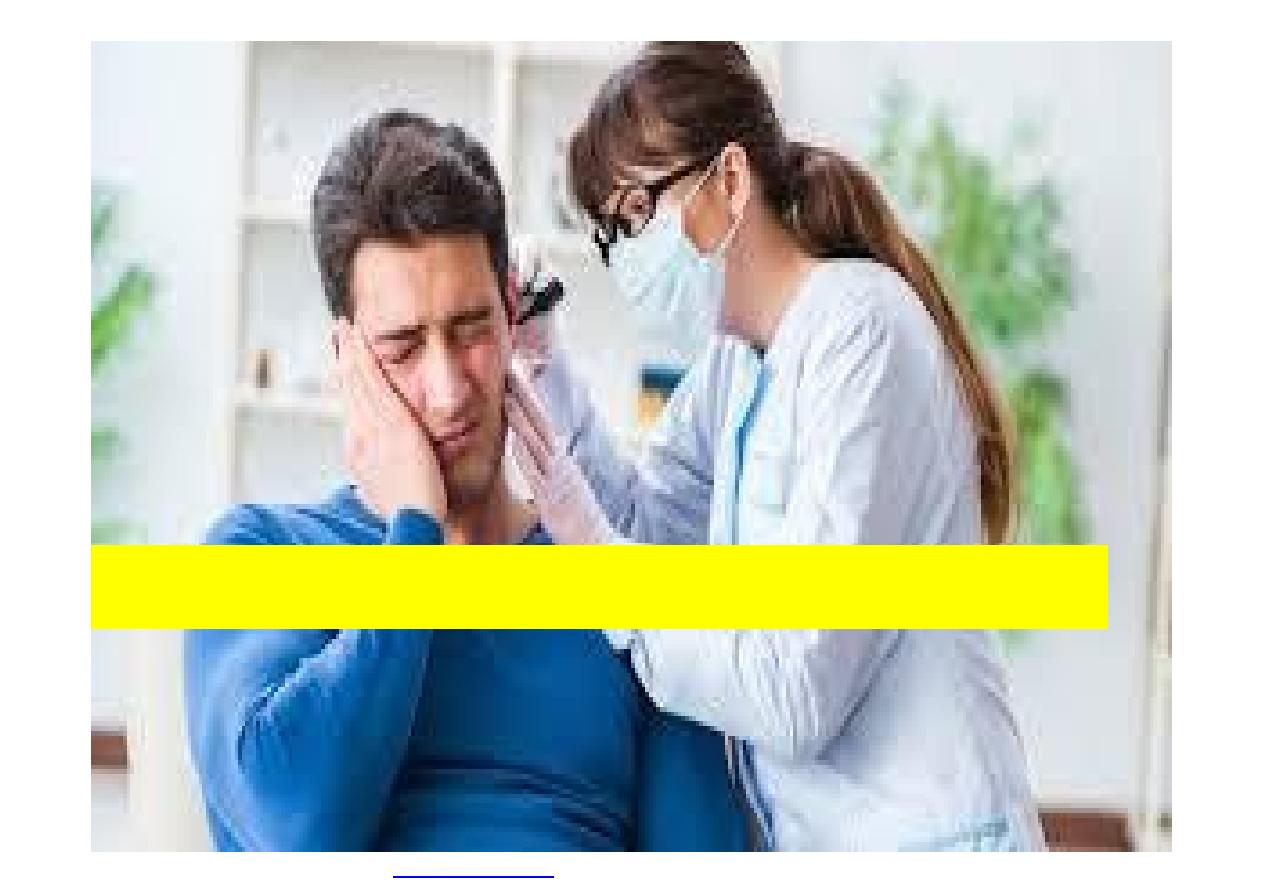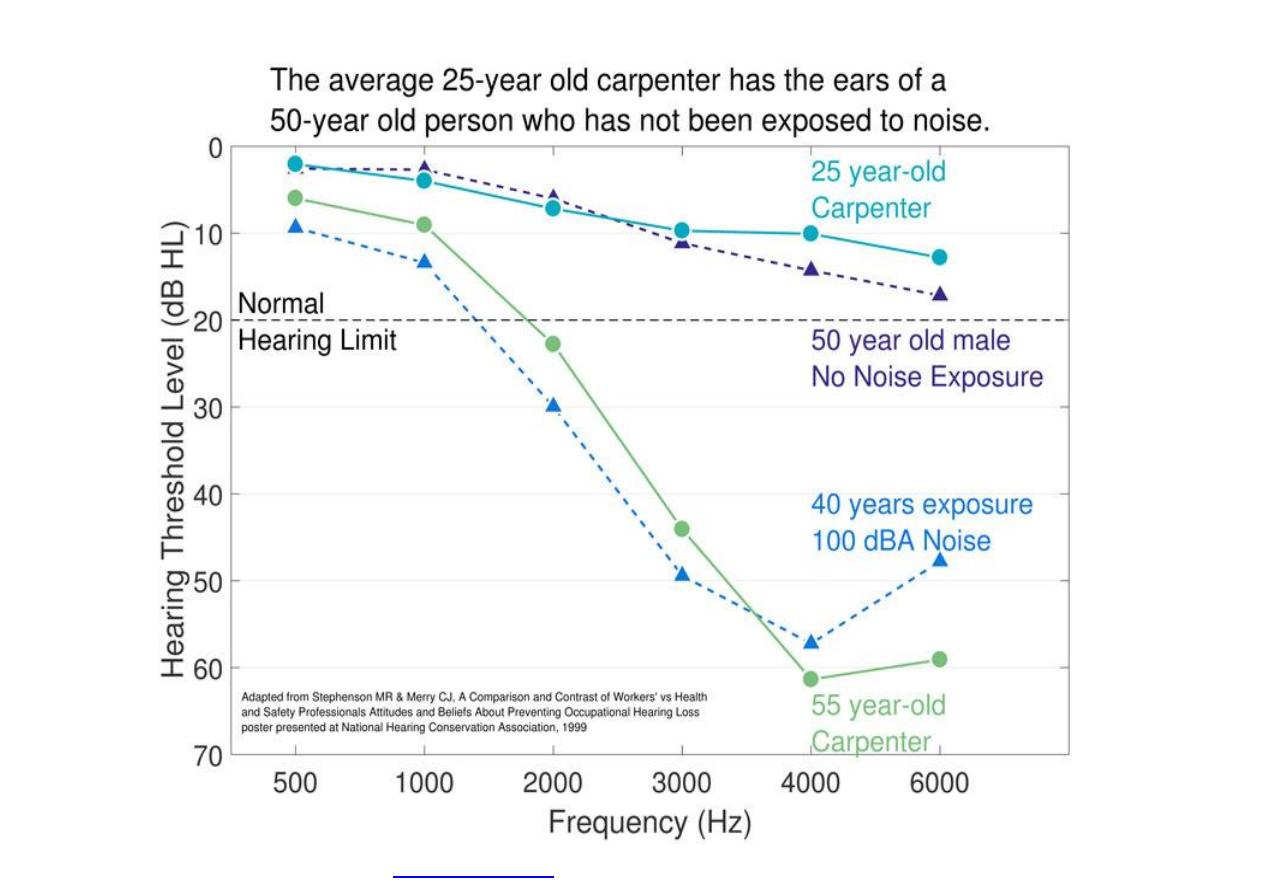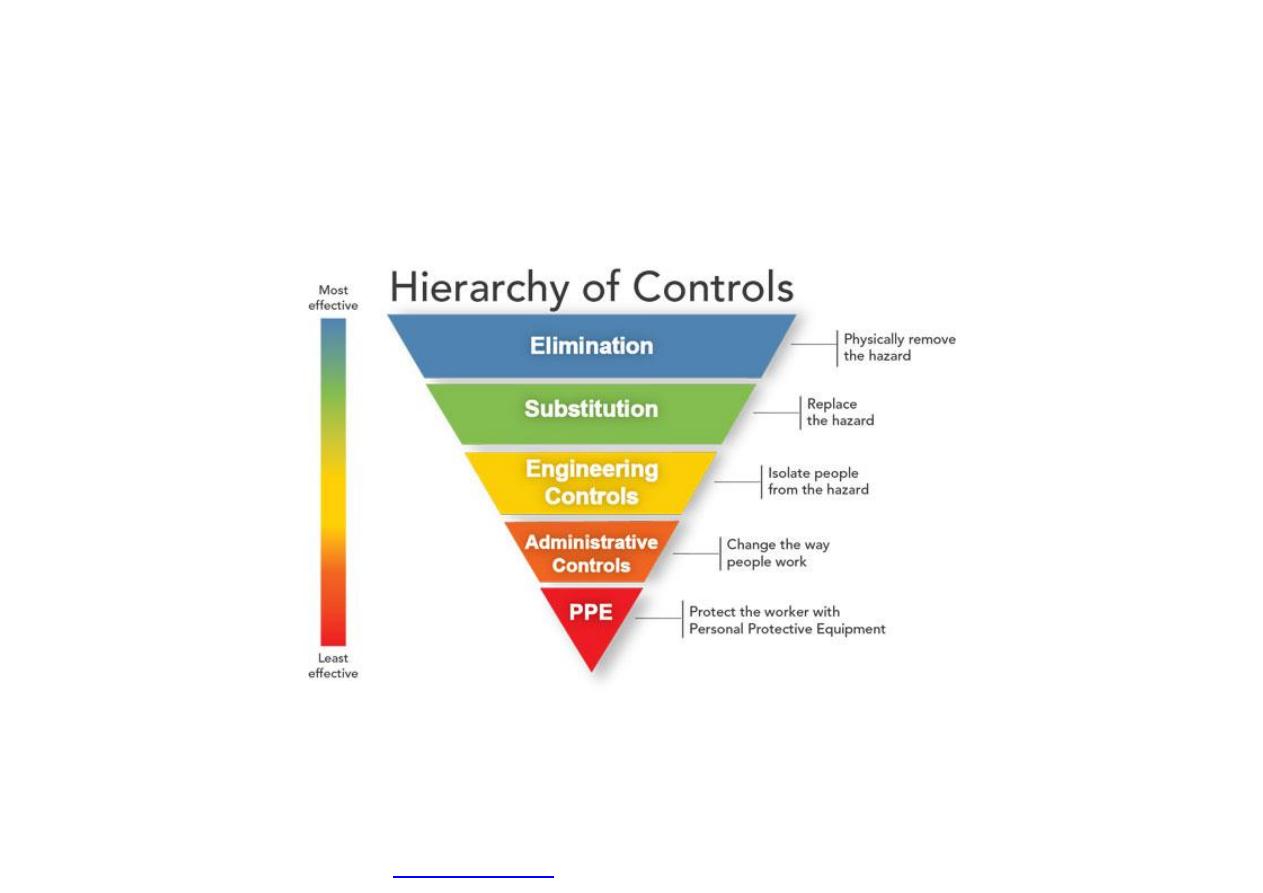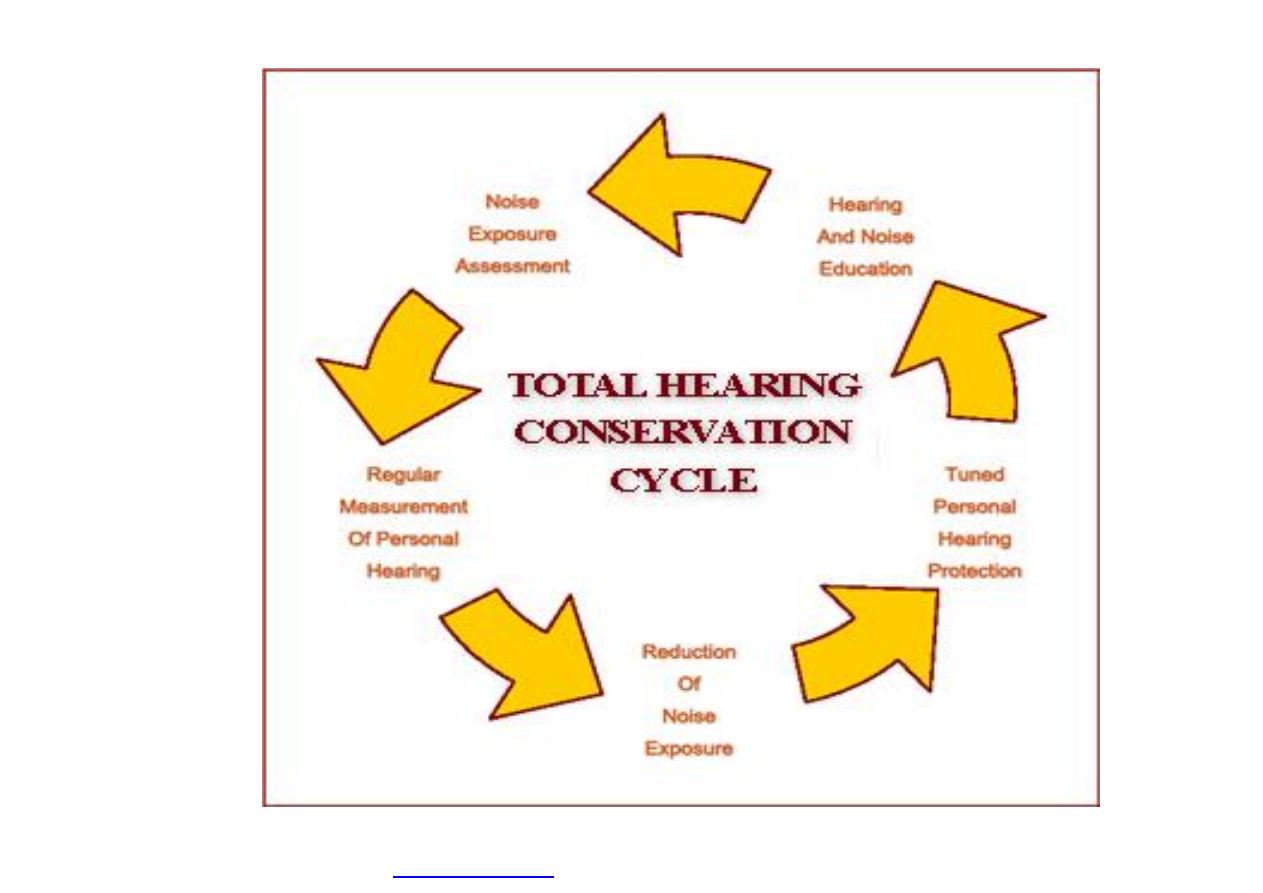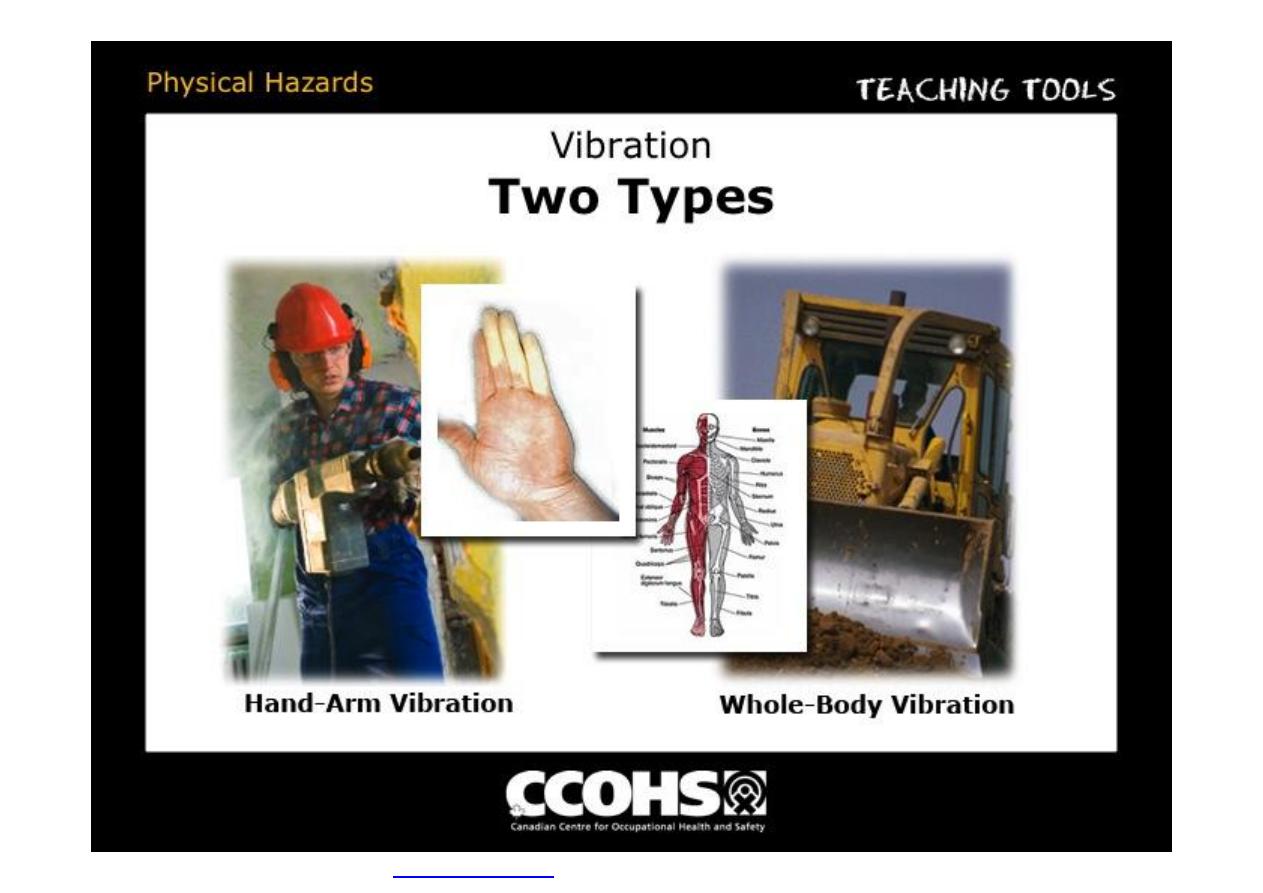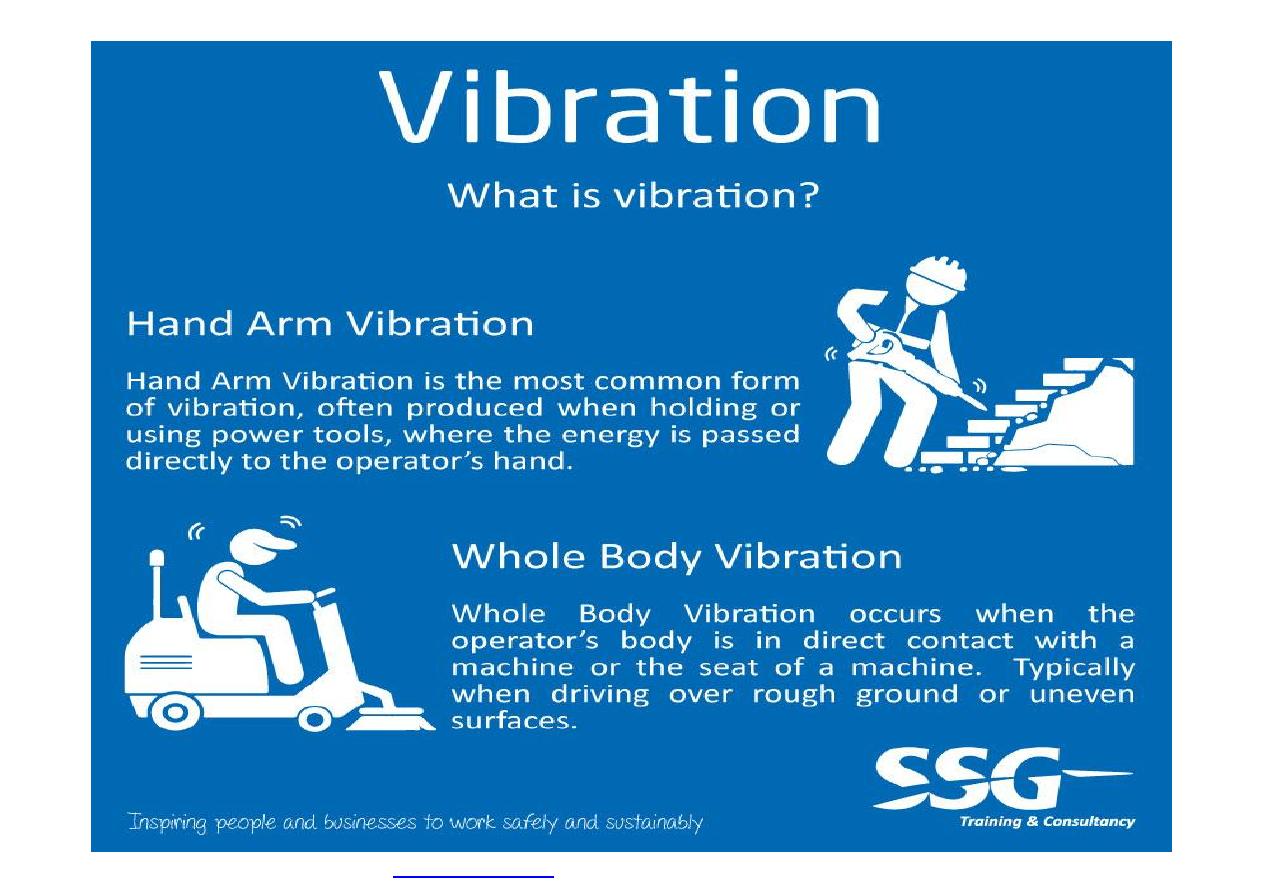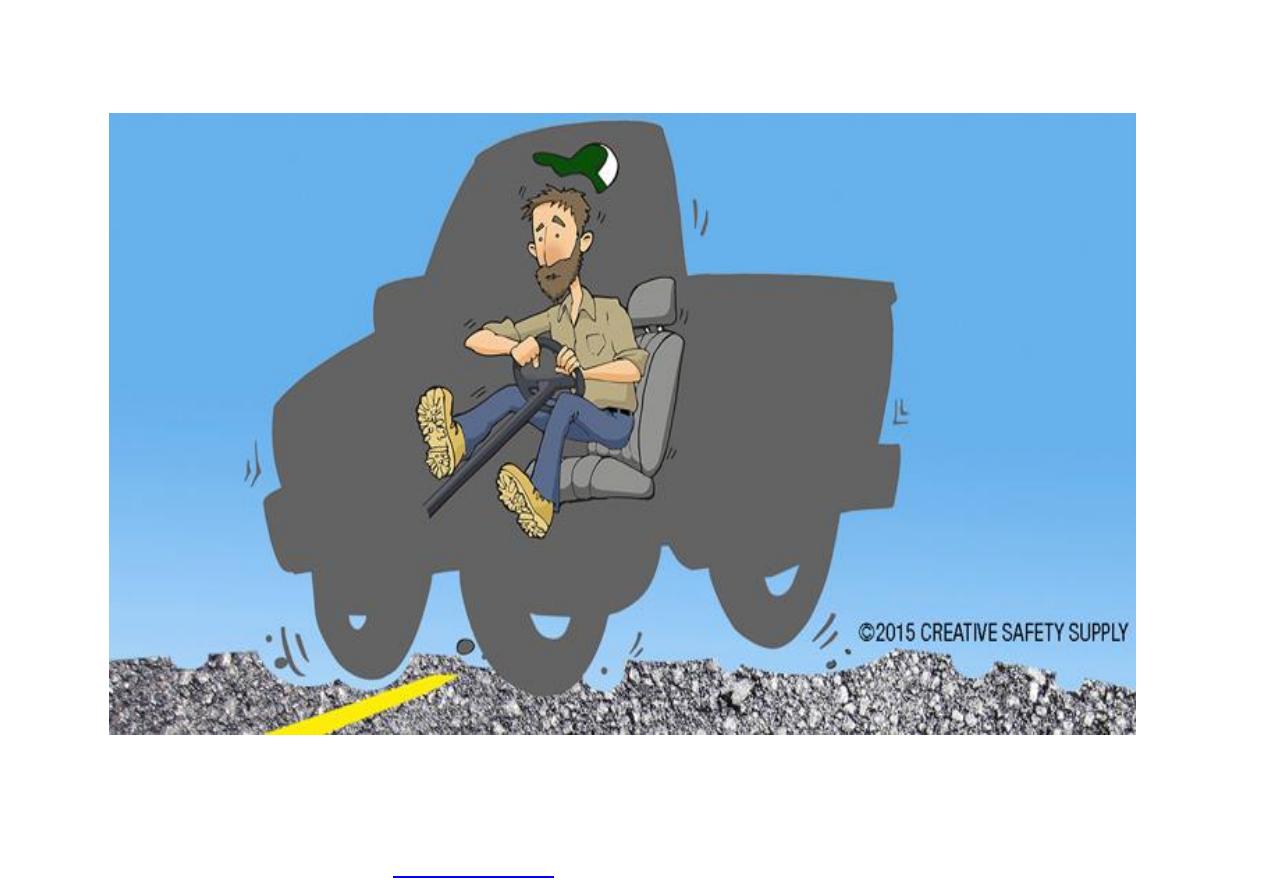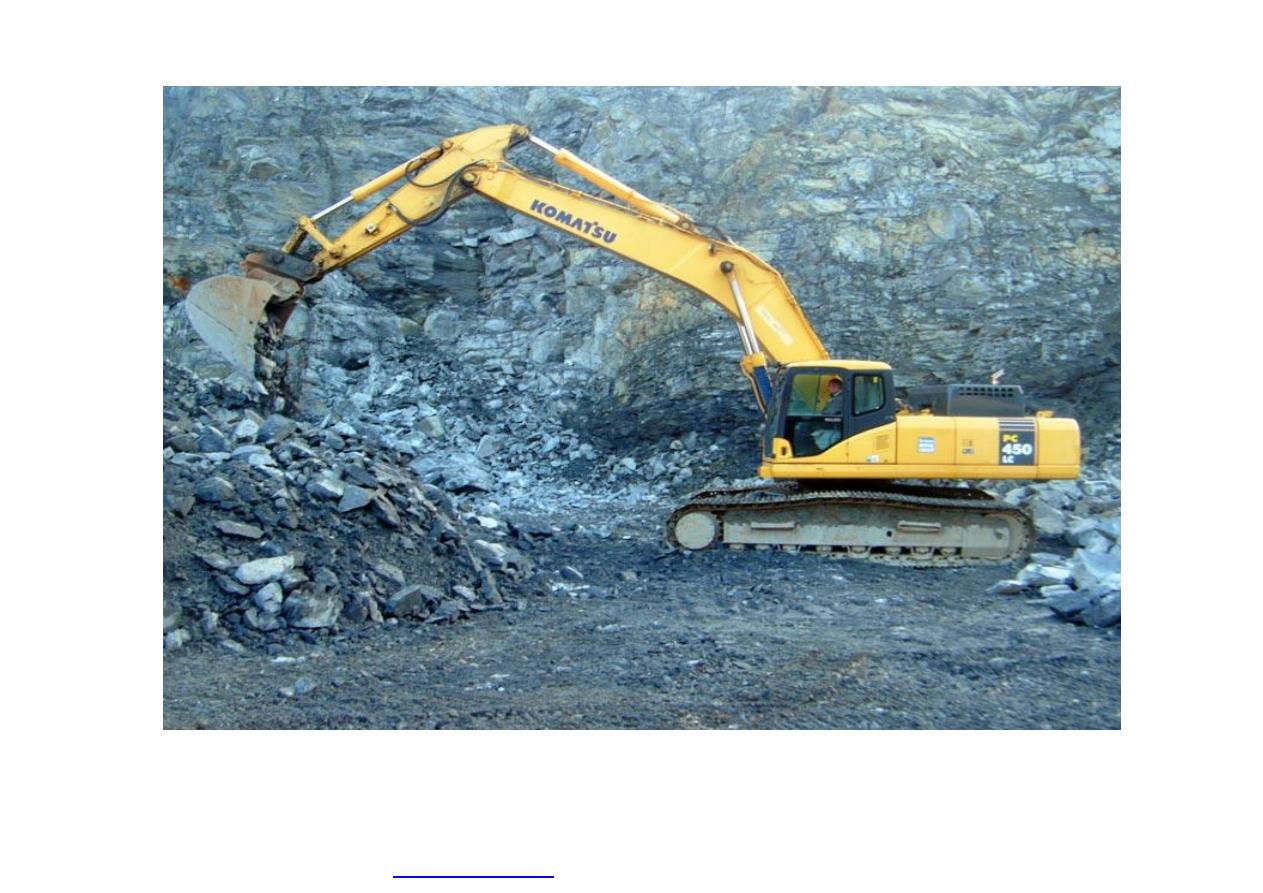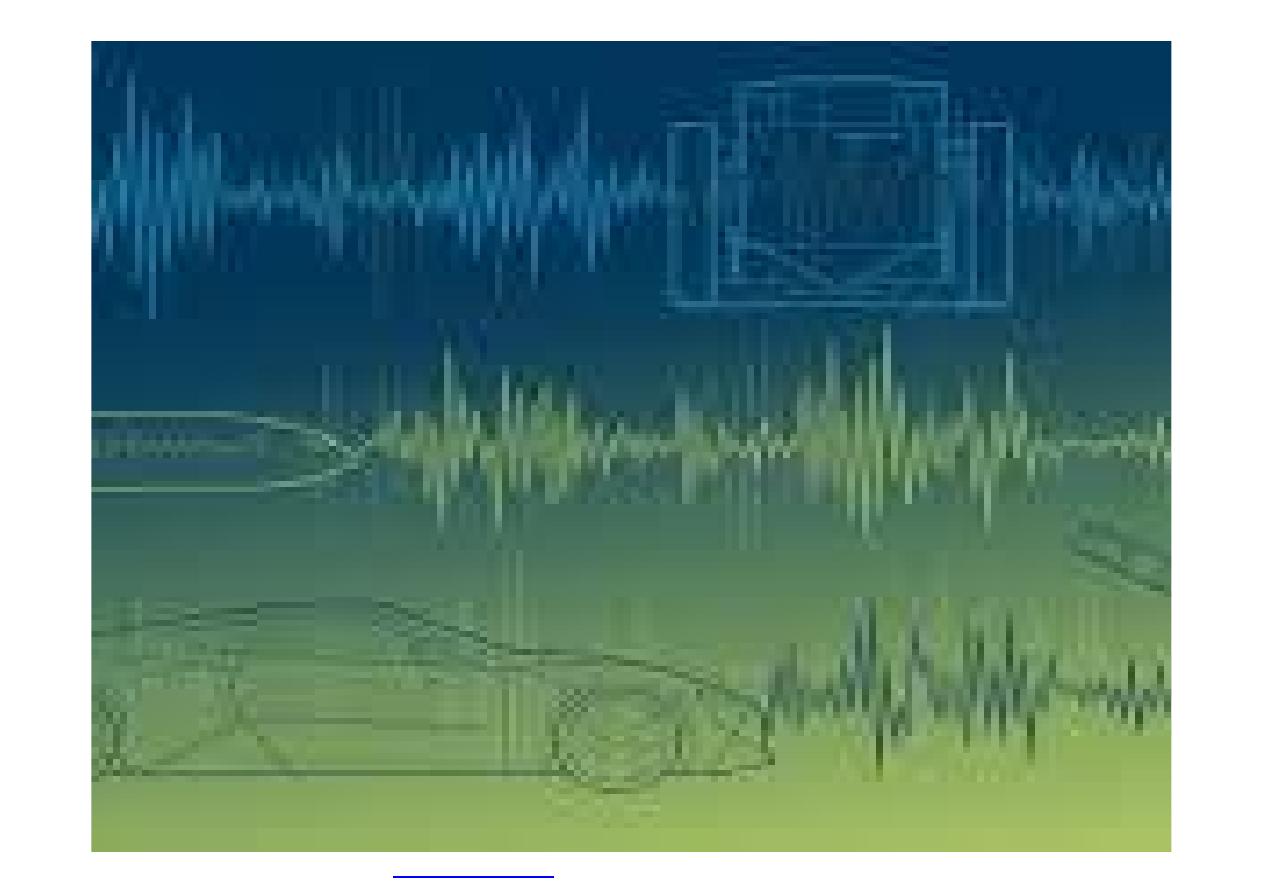
Occupational Physical Hazards
(Cont.)
Noise, Pressure and Vibration
.
By
Dr. Ashraf Hussain
MBChB, PhD/Com. Med
PDF created with pdfFactory Pro trial version
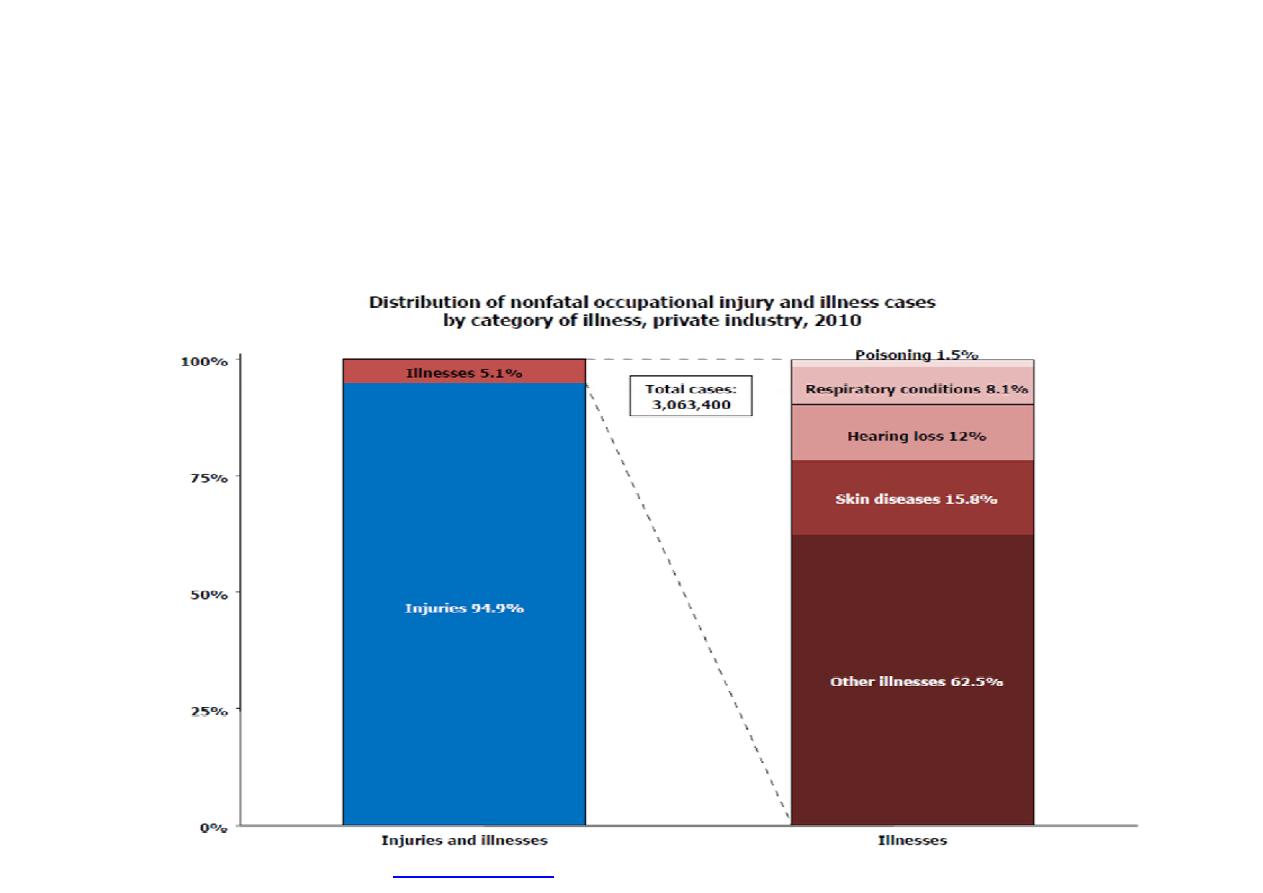
•
Noise
is an unwanted, unpleasant or undesirable
sound
•
It is one of the most common occupational hazards.
PDF created with pdfFactory Pro trial version
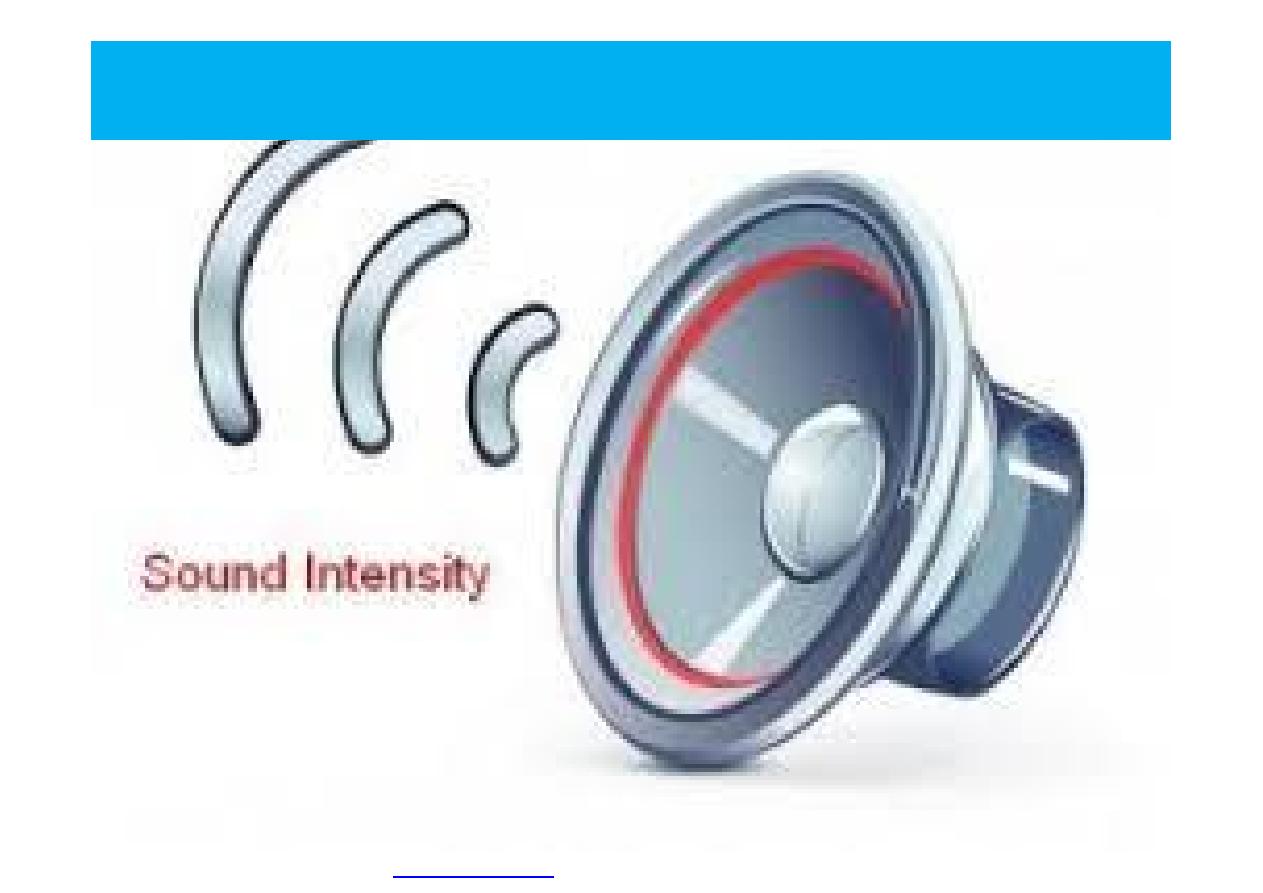
•
Intensity is the loudness of the sound
measured in decibels (dB).
•
The scale runs from the faintest sound the
human ear can detect, which is labeled 0 dB, to
over 180 dB, the noise at a rocket pad during
launch.
Intensity or Loudness
PDF created with pdfFactory Pro trial version
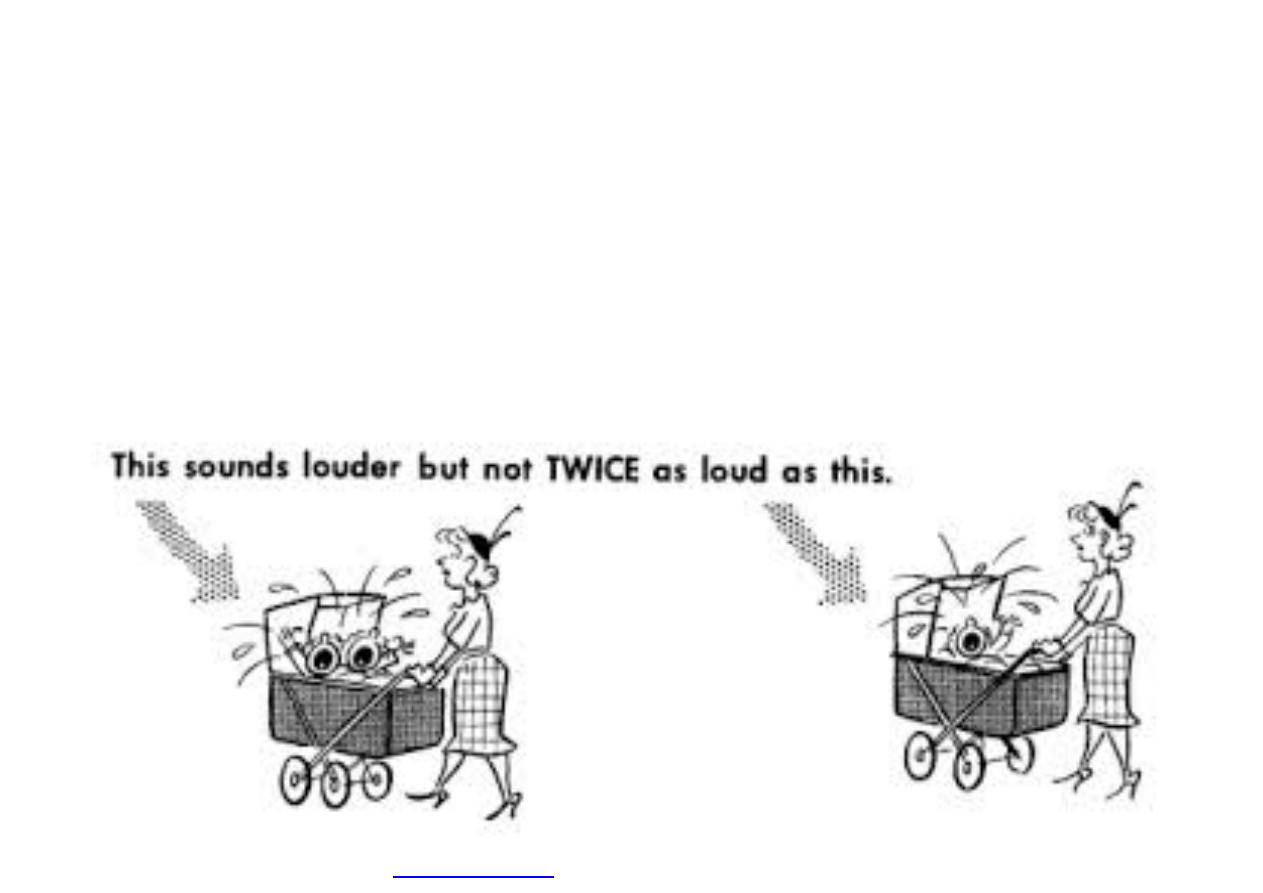
•
The decibel scale is a logarithmic scale, not a
linear scale, small numbers represent
enormous changes. Sound energy that is
twice the level of 83 dB is not 166 dB, rather
86 dB.
PDF created with pdfFactory Pro trial version

measure the frequency of sound vibrations per
second, called
Hertz (Hz)
.
Ø
Frequency is measured in cycles per second,
or Hertz (Hz).
Ø
A low pitch such as a deep voice or
a tuba makes fewer vibrations per
second than a high voice or violin.
Frequency or Pitch of the sound
PDF created with pdfFactory Pro trial version
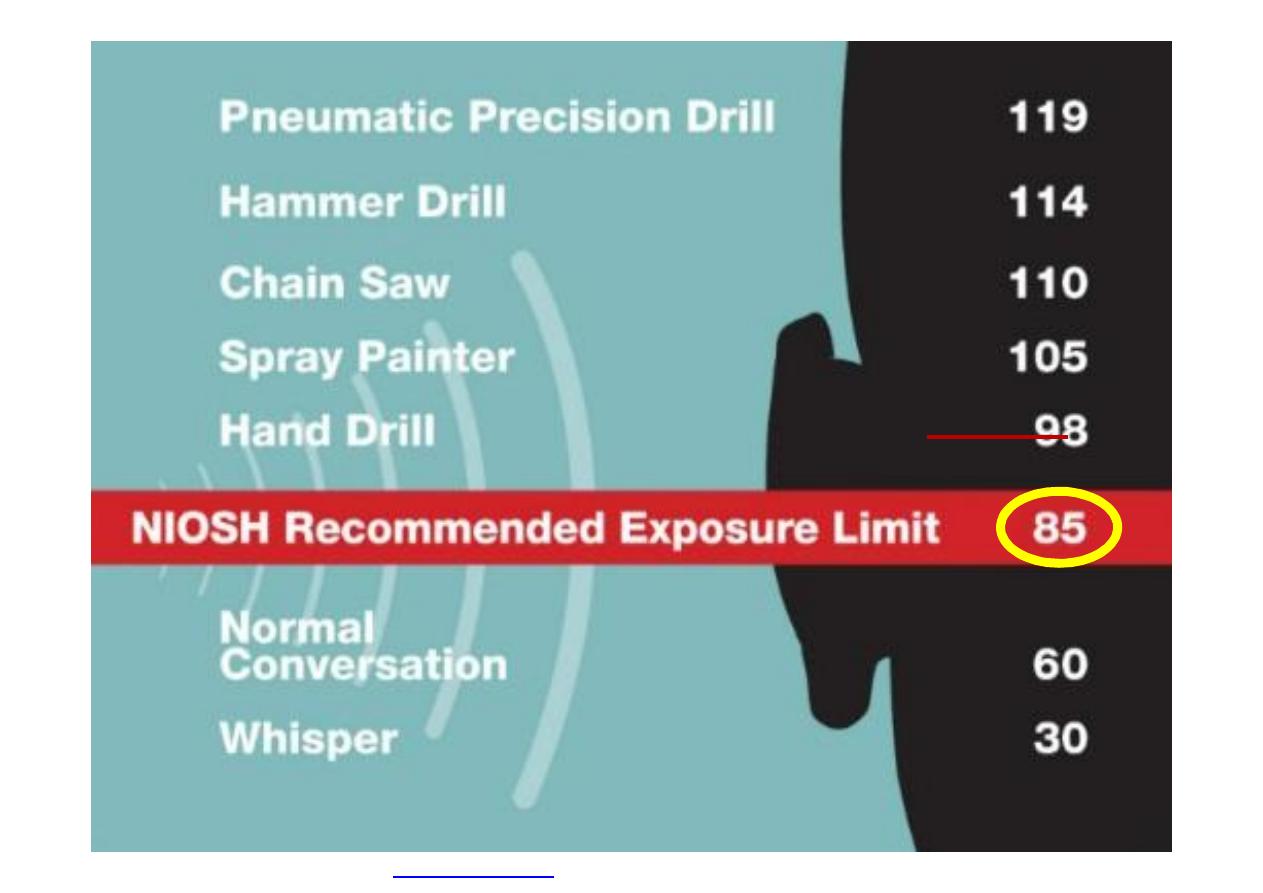
••
Exposure limits in noise exposure are a
Exposure limits in noise exposure are a
trade
trade--off between sound level (measured in
off between sound level (measured in
decibels) and duration of exposure (time).
decibels) and duration of exposure (time).
••
For an
For an 88--hour exposure, for example, the
hour exposure, for example, the
maximum permissible sound level is
maximum permissible sound level is
90
90 dB.
dB.
••
Anything beyond
Anything beyond 8
8 hours at this noise level
hours at this noise level
is not allowed.
is not allowed.
PDF created with pdfFactory Pro trial version
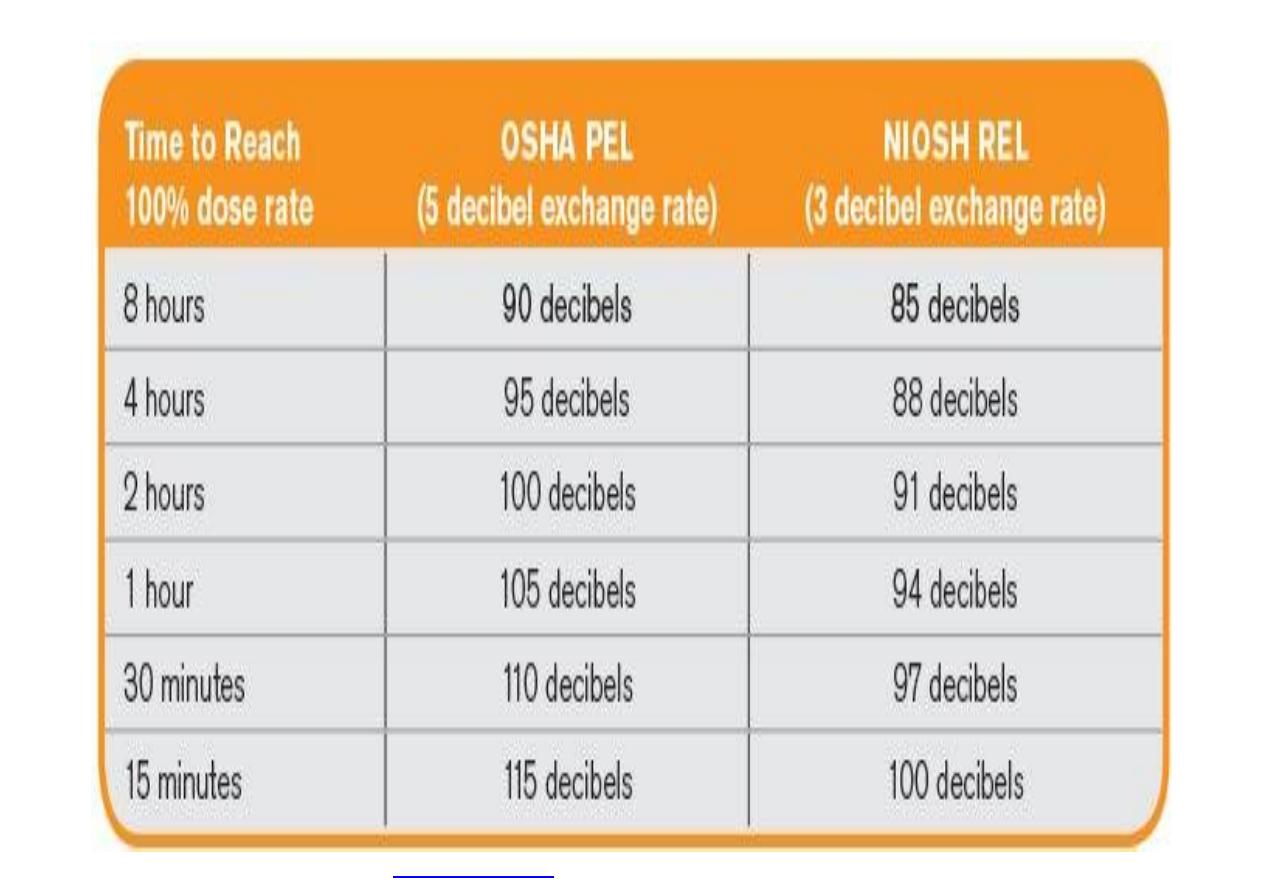
•
In a time-weighted average (TWA), greater
noise levels require shorter exposure times,
and lower noise levels allow longer exposure
times.
•
For example greater exposure levels, such as
95 dB, the maximum allowed exposure time is
only 4 hours.
PDF created with pdfFactory Pro trial version

Occupational Hazards of Noise
A. Acoustic effect:
1. Conductive hearing loss: explosive sound that
damage the eardrum or the middle ear. This
type is reversible.
2. Sensory neural hearing loss
PDF created with pdfFactory Pro trial version

•
Temporary threshold shift
: temporary rise of
auditory threshold which results from noise
induced fatigue of the nerve sensitivity.
•
It usually recovers within 16 hours.
•
If noise continue then it will be permanent.
•
permanent threshold shift then is the
Noise Induced Hearing Loss.
PDF created with pdfFactory Pro trial version

•
Noise Induced Hearing Loss is a permanent
hearing impairment resulting from prolonged
exposure to high levels of noise.
•
When noise is too loud, it begins to kill cells in
the inner ear.
•
As the exposure time to loud noise increases,
more and more hair cells are destroyed.
•
As the number of hair cells decreases, so does
hearing.
•
Currently, there is no way to restore life to
dead hair cells; so the damage is
Permanent
.
PDF created with pdfFactory Pro trial version

•
Noise-Induced Hearing Loss
•Causes no pain
•Causes no visible trauma
•Leaves no visible scars
•Is unnoticeable in its earliest stages
•Accumulates with each overexposure
•Takes years to notice a change
Is Permanent + 100% Preventable
PDF created with pdfFactory Pro trial version

•
Sensori Neural Hearing Loss can be caused by
several factors other than noise as aging,
some diseases, but noise-induced hearing loss
is different in one important way –
it can be
reduced or prevented all together
.
PDF created with pdfFactory Pro trial version

Non-auditory health and physiological effects
of noise
1. Nervousness, fatigue and annoyance
2. Interference in communication by speech
3. Raises the blood pressure, heart rate and
the stress hormone levels.
4. Disrupt healthy sleep patterns.
5. Increase the risk of accidents.
PDF created with pdfFactory Pro trial version

•
At first no signs or symptoms
•
Recognition of hearing impairment occurs
when the loss reaches the human speech
frequencies (500-2000) Hz
•
First symptom is tinnitus (ringing) or sensation
of blocked ear .
•
Close talk in a crowed become difficult to
understood.
•
Then the words become distorted or
unpleasant to hear
PDF created with pdfFactory Pro trial version
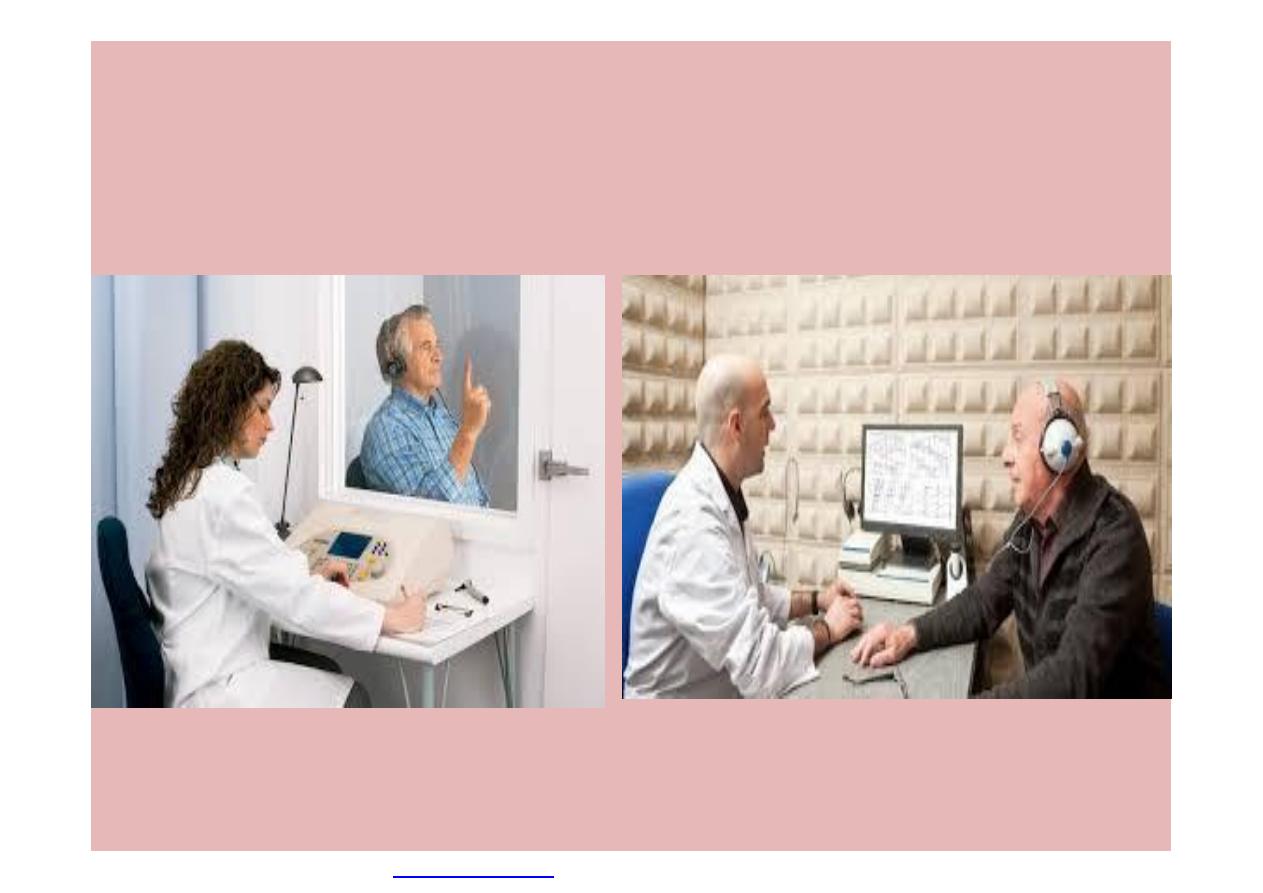
Audiometric Testing
•
Audiometric testing is the aid test of whether
a Hearing Conservation Program is effective or
not.
•
Monitors employee’s hearing over time
•
Baseline audiogram must be performed within
first 6 months of work exposure ( 8 hour TWA
≥ 85 dBA)
•
Annual audiograms are required each year
after baseline audiogram
PDF created with pdfFactory Pro trial version

•
Annual audiograms are compared back to
each employee’s baseline audiogram to
determine if a significant shift in hearing has
occurred (
a 10 dB average shift at 2000-4000
Hz in either ear).
•
If a shift occurs, and is found to be due to
noise exposure, the employee must be
retrained/refit with hearing protectors.
PDF created with pdfFactory Pro trial version

Controlling risks of noise exposure
Implementing one or more of the following hierarchy of
control measures can manage excessive noise levels, in
order of effectiveness:
1. Eliminating the noise source.
2. Substituting noisy machinery with quieter machinery
or 'buying quiet' - this is a cost-effective way to
control workplace noise at the source.
3. Engineering controls by treating the noise at the
source or in its transmission path e.g. using sound
dampeners or silencers, noise barriers and isolation.
PDF created with pdfFactory Pro trial version

4. Introducing administrative noise control
measures e.g. training and education, job
rotation, job redesign or designing rosters to
reduce the number of workers exposed to noise.
5. Providing Personal Protective Equipment (PPE)
e.g. earmuffs, earplugs. However, if workers are
frequently required to wear PPE to reduce the
risk of hearing loss from a noise exposure that
exceeds the exposure standard, then an
audiometric testing regime must be
implemented
PDF created with pdfFactory Pro trial version
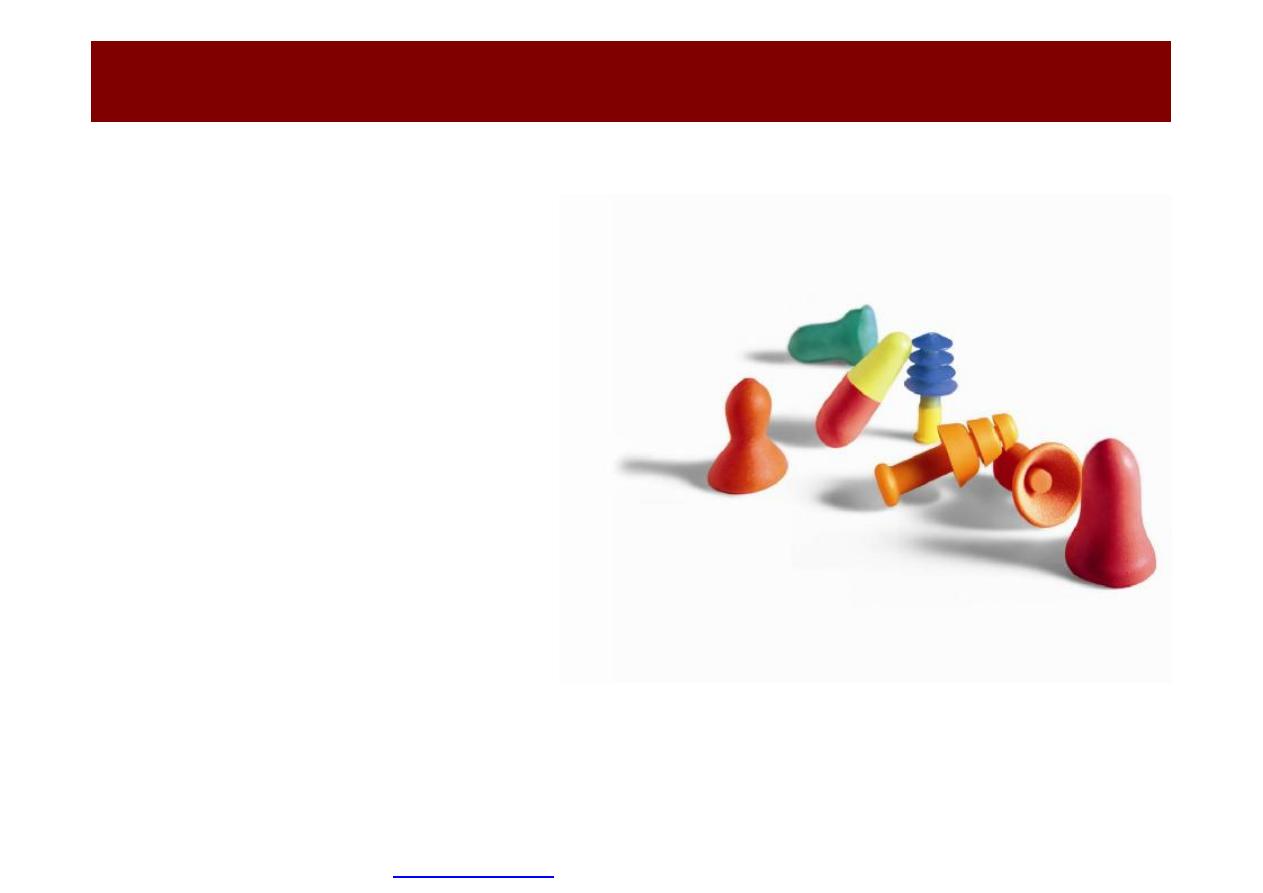
Hearing Protection Selection
Earplugs
•Comfortable for extended use
•Cooler in hot/humid
environments
•Single-use foam plugs can
provide highest levels of
attenuation
PDF created with pdfFactory Pro trial version
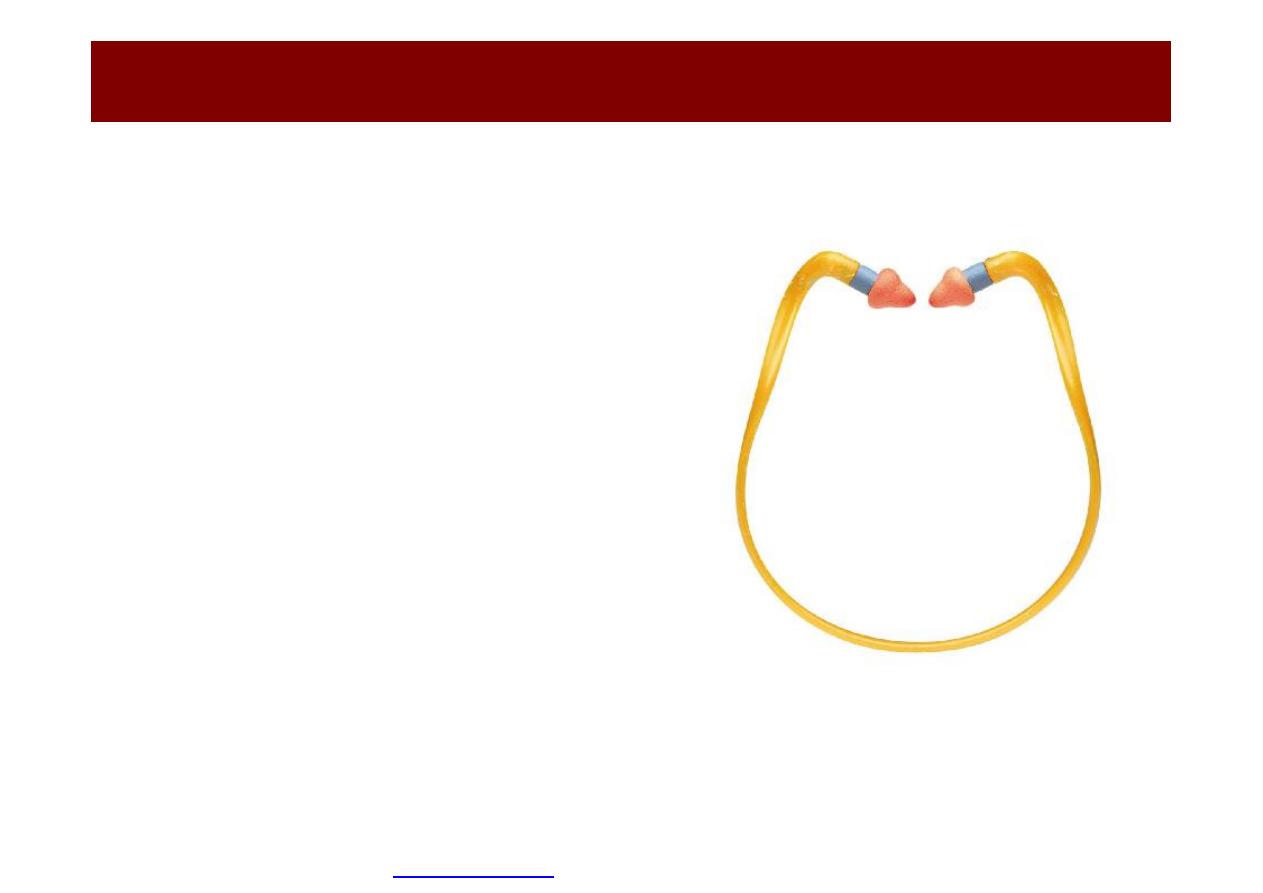
Hearing Protection Selection
Bands
•Very convenient for intermittent
noise
•Readily available around neck when
not in use
PDF created with pdfFactory Pro trial version
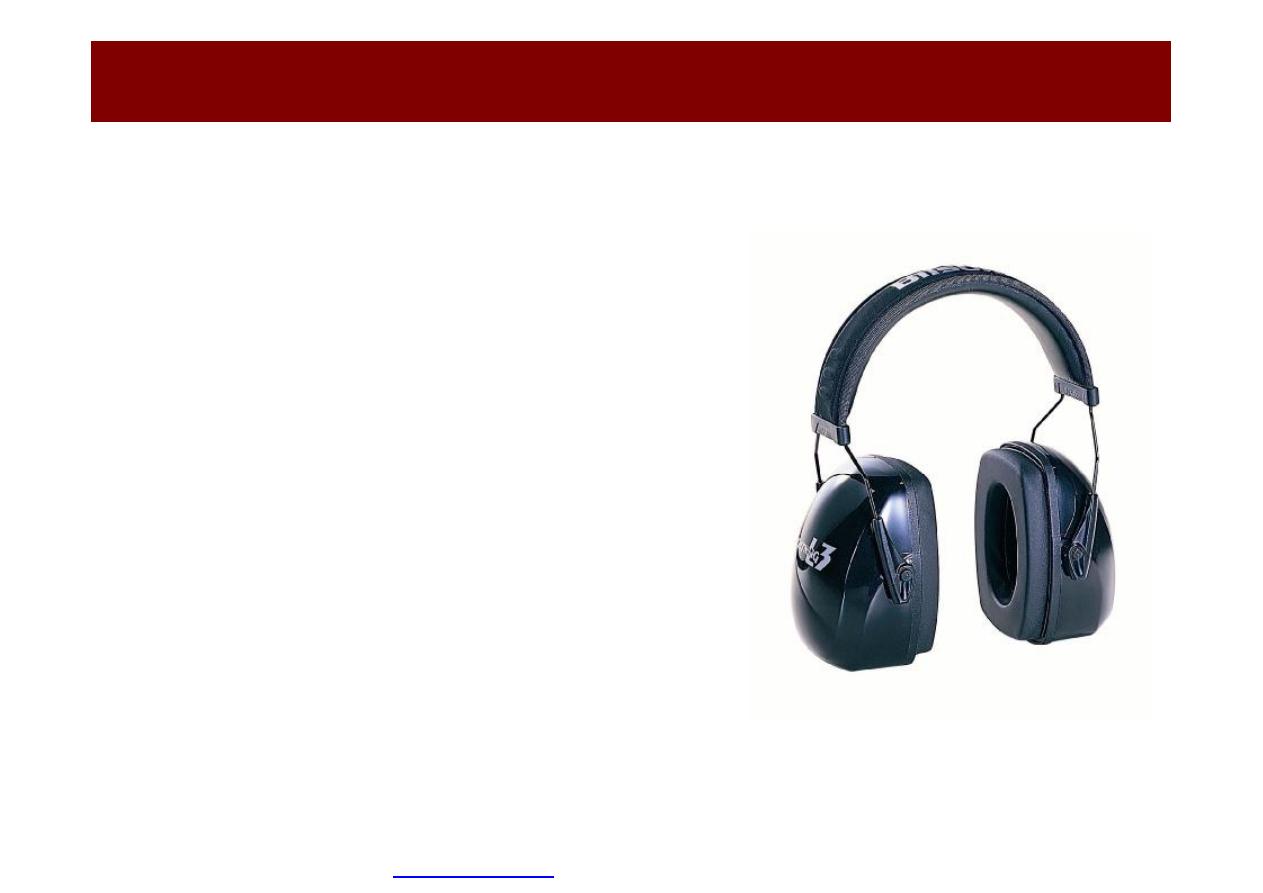
Hearing Protection Selection
Earmuffs
•Easy to get proper fit
•Good for intermittent noise
•Radio & electronic options
PDF created with pdfFactory Pro trial version
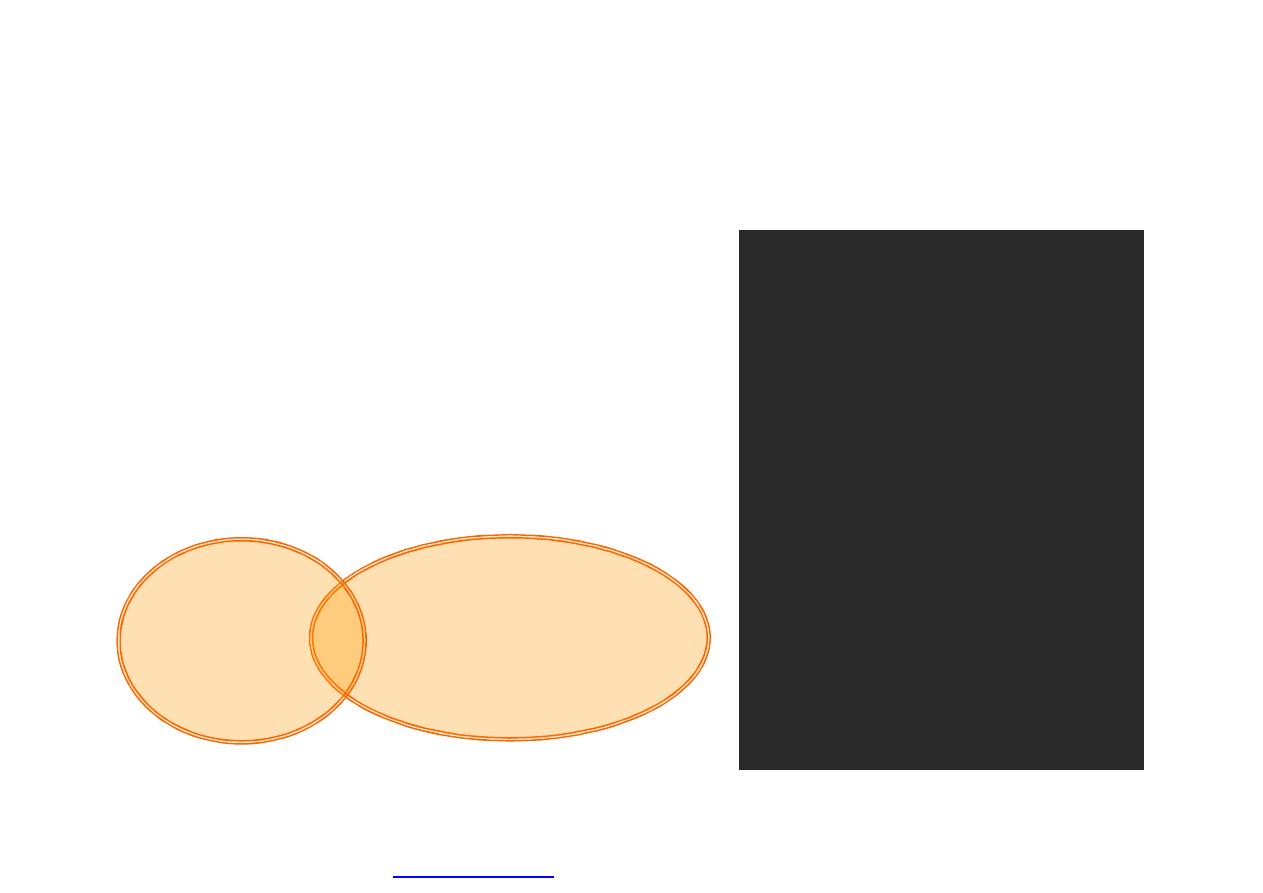
Ototoxic by themselves
• Synergistic effect with noise
• Large differences in sensitivity
• Recommend: increased frequency of
audiometric testing
Synergistic Ototoxics
• Carbon Monoxide
• Hydrogen Cyanide
NOISE
NOISE AND ACOUSTICS ~ Hierarchy of Controls
Noise + Acoustics
Ototoxic Chemicals
Confirmed Ototoxics
Ethyl Benzene
Lead and inorganic
compounds (as Pb)
Styrene
Toluene
Trichloroethylene
Possible
Carbon disulfide
n-Hexane
Xylene
PDF created with pdfFactory Pro trial version

caused by poorly designed or poorly maintained
vehicles, platforms or machinery as in uneven
roads, Fork lift and Quarrying.
a. Whole body vibration
PDF created with pdfFactory Pro trial version

•
Acute effects cause discomfort: nausea, vomiting,
loss of balance may appear after work.
•
Fatigue, dizziness, headache, sleep disorders also
might develop.
•
Oscillation of organs due to vibration has an
effect on their body functions.
•
Vibration around 1 Hz affects the sense of balance.
•
Vibration in the range of 3-6 Hz affects organs in the thorax and
abdomen.
•
Vibration in the range of 20-30 Hz targets the head, neck and
shoulders.
•
Whole body vibration of higher frequencies can lead to
gynaecological complaints among women
PDF created with pdfFactory Pro trial version

•
Long term exposure to WBV may lead to:
•
Lower back pain (Degeneration of the
intervertebral discs is more common, more
severe and its onset is earlier in workers
exposed to whole-body vibration than in the
non-exposed population and ligaments
loosened from shaking).
•
Motion sickness
•
Bone damage
•
The longer a worker is exposed to WBV, the
greater the risk of health effects and muscular
disorders.
PDF created with pdfFactory Pro trial version
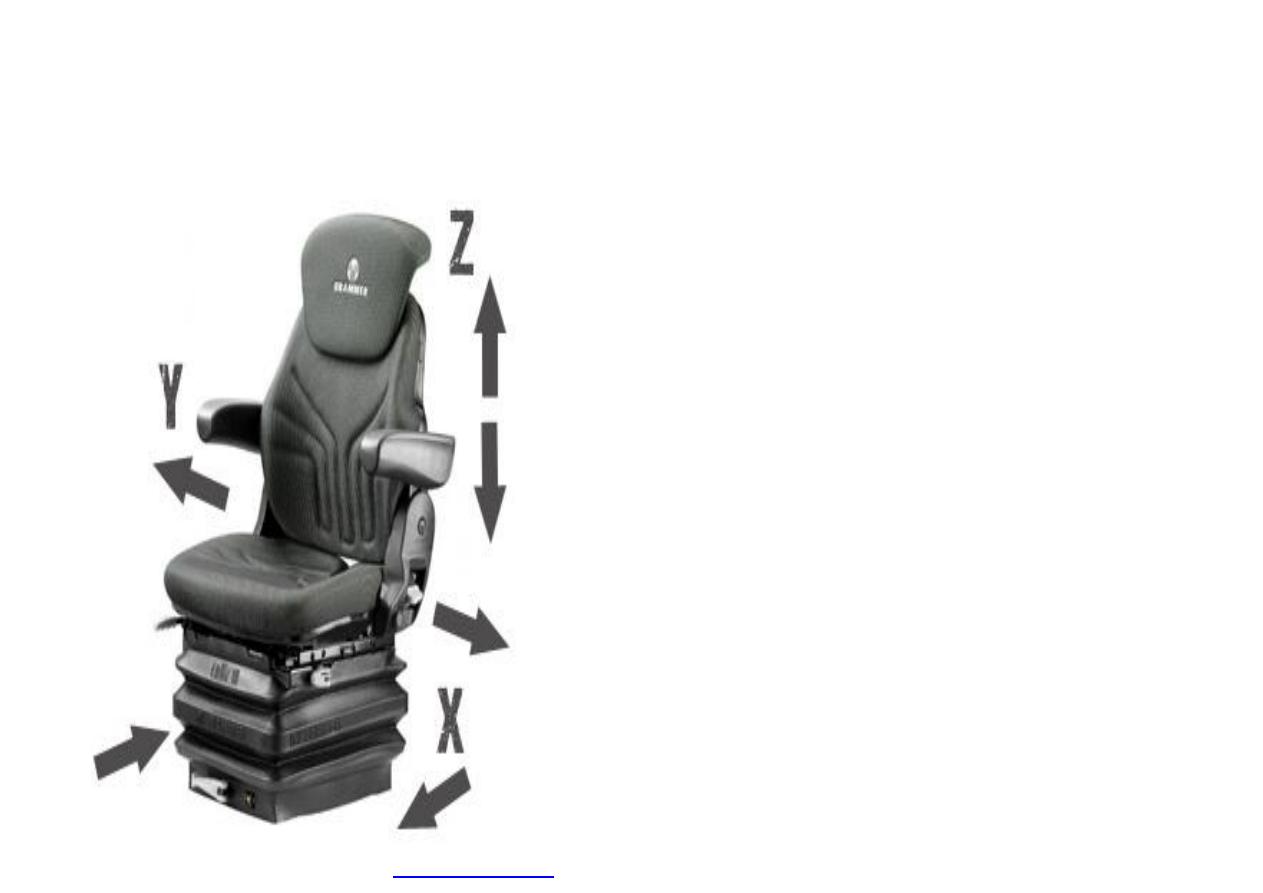
Prevention:
i
_
Education of workers about
vibration transmission and to take
breaks , posture changes , reduce
exposure time
ii
_
preference for buying machines
and vehicles designed to reduce
transmission of vibration
iii
_
suspension seats
PDF created with pdfFactory Pro trial version
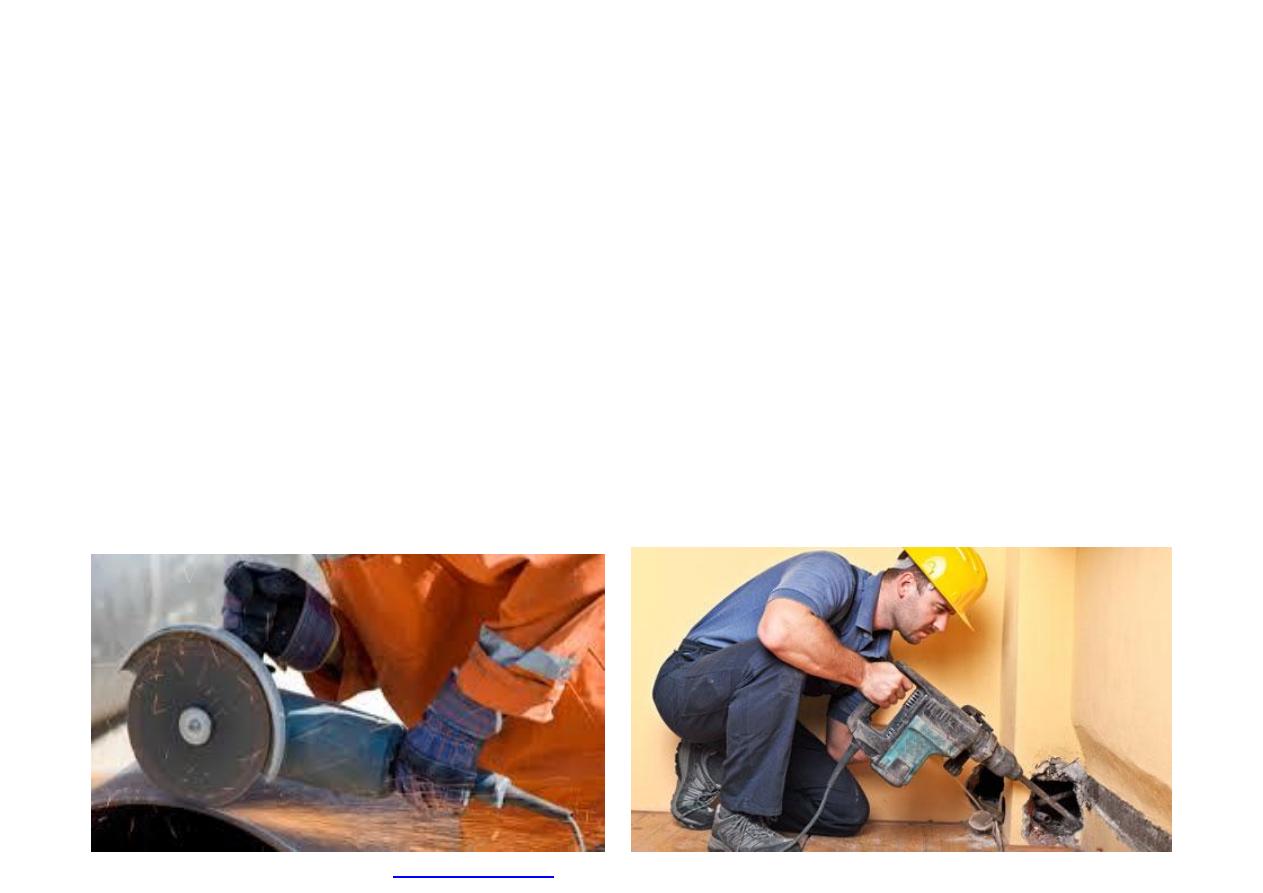
2- Local body vibration
**
**
hand-arm vibration
Occurs in the
arms , hands and fingers
when
working with a vibration tool or machinery as in
drill hammering
It affects tendons, muscles, bones and joints, and
can affect the nervous system
PDF created with pdfFactory Pro trial version

•
Vibration induced health conditions progress
slowly.
•
In the beginning it usually starts as a pain.
•
As the vibration exposure continues, the pain
may develop into a condition called Hand Arm
Vibration Syndrom (HAVS)
•
It may take a few months to several years for
the symptoms of HAVS to become clinically
noticeable
PDF created with pdfFactory Pro trial version
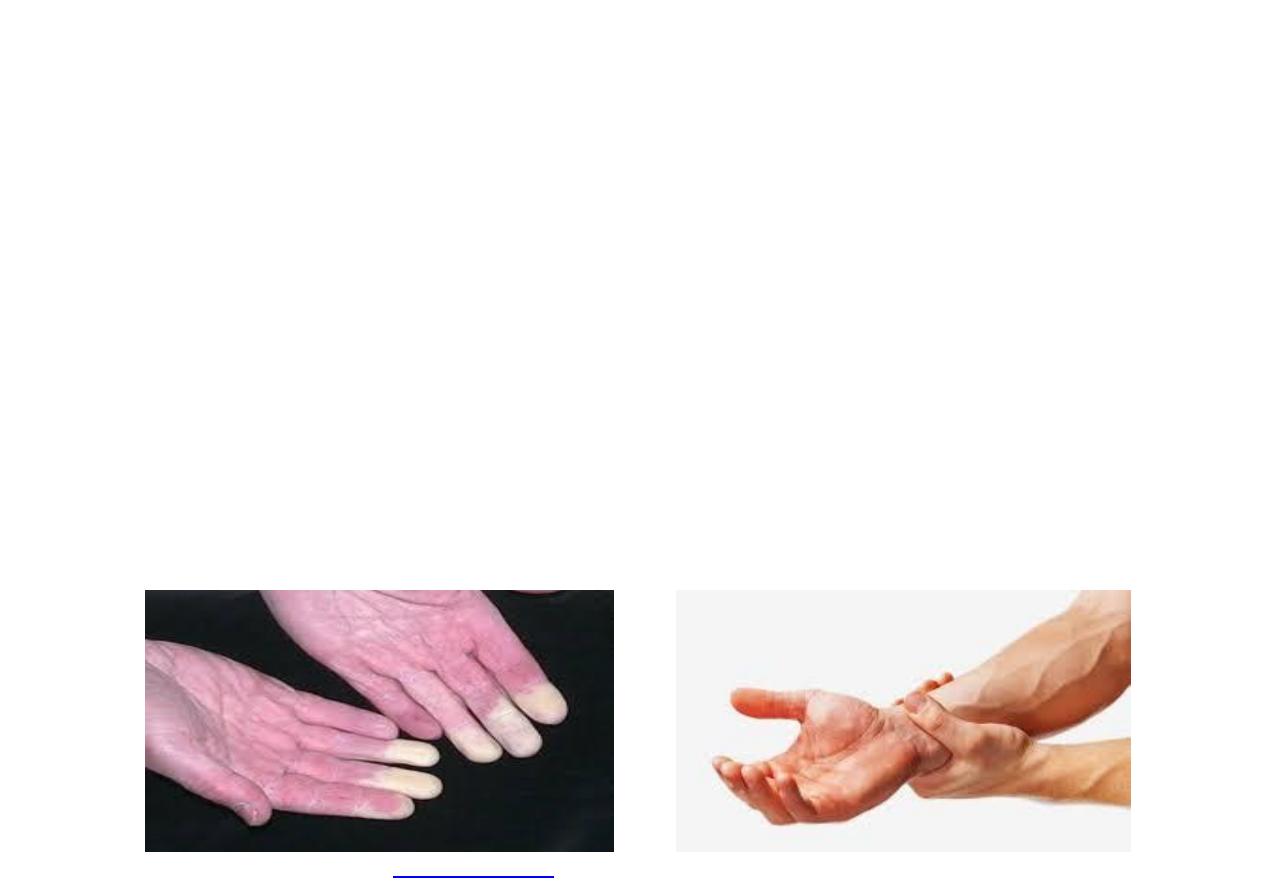
Symptoms include:
•
attacks of whitening (blanching) of one or more
fingers when exposed to cold
•
tingling and loss of sensation in the fingers
•
loss of light touch
•
pain and cold sensations between periodic white
finger attacks, especially upon cold exposure
•
loss of grip strength
•
bone cysts in fingers and wrists
PDF created with pdfFactory Pro trial version

Risk factors
•
Frequency and acceleration of Vibration set.
•
Duration of exposure and years of
involvement in Vibration work.
•
Protective practices and equipment including
gloves, boots, work-rest periods.
•
Skill, operator control and grip forces - how
hard the worker grasps the vibrating
equipment.
PDF created with pdfFactory Pro trial version

•
Smoking and use of drugs and exposure to
other physical and chemical agents.
•
State of tool maintenance
•
Hardness of the material being contacted by
the machine (for example metal in grinding
and chipping)
PDF created with pdfFactory Pro trial version
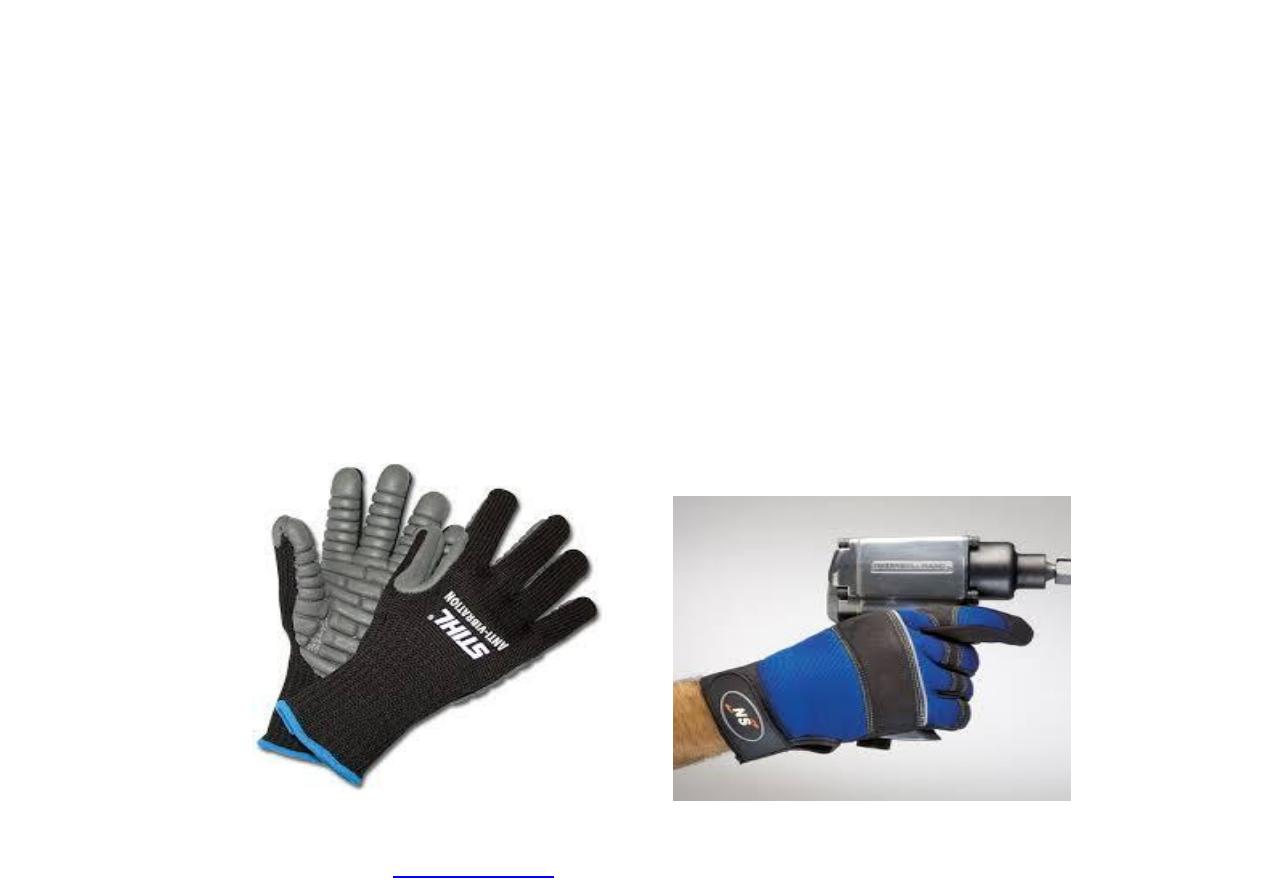
Prevention
1- Use of anti vibration gloves
Reduce the vibration from handheld machines
PDF created with pdfFactory Pro trial version

2. Take regular breaks of at least 10 minutes away
from the tool
3. Use tools correctly and use the right tool for the
job.
4. Avoid use of excessive grip, nor to use a tool for
longer than necessary.
PDF created with pdfFactory Pro trial version

•
Decompression sickness
is a disease results from
exposure to high or low atmospheric pressure.
•
Also called Bends or Caisson disease.
•
It occurs in scuba divers, tunnel workers or high
altitude or aerospace events when dissolved
gases (mainly nitrogen) come out of solution in
bubbles.
•
Under increased atmospheric pressure, fat-
soluble nitrogen gas dissolves in the body fluids
and tissues.
•
During decompression the gas comes out of
solution and, if decompression is rapid, it forms
bubbles in the tissues.
PDF created with pdfFactory Pro trial version

•
Similarly, the gases in solution in the body tissues
under normal atmospheric pressure form bubbles
when pressure rapidly decreases, as when
aviators in unpressurized aircraft ascend to high
altitudes too quickly.
•
affect any body area including joints, lung, heart,
skin and brain.
•
Bubbles cause pains in the limbs (known as the
bends) and mild cutaneous symptoms.
•
Also breathlessness, angina, headache, dizziness,
collapse, coma, and in some cases death.
PDF created with pdfFactory Pro trial version

•
Emergency treatment of decompression
sickness consists of rapid recompression in a
compression chamber with gradual
subsequent decompression.
•
The condition can be prevented by allowing
sufficient decompression time for the excess
nitrogen gas to be expelled naturally.
PDF created with pdfFactory Pro trial version


